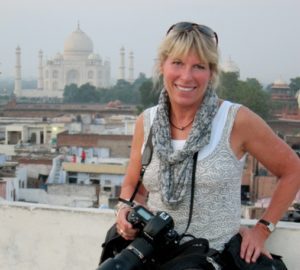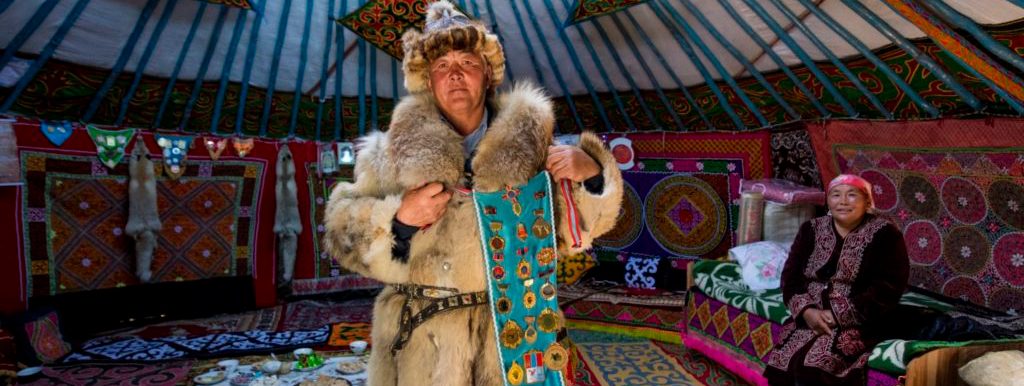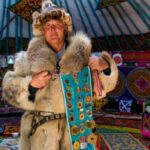Alison Wright Q&A:
The Leading Documentary Photographer on her Work and Travel
Ever wondered how a photographer views people and places as they travel? This interview comes as close to answering that question as you can get without joining Alison Wright on one of her acclaimed photo tours. The New York-based photographer has spent a career capturing the universal human spirit through her photographs and writing. For many of her projects, she travels to all regions of the globe photographing indigenous cultures and people while covering issues concerning the human condition.
She has traveled to 150 countries as a contributor to outlets including National Geographic, Outside, CNN, The Travel Channel, Discovery, Smithsonian, The New York Times and UNICEF. And she has published ten books including her most recent, Human Tribe, a series of portraits celebrating our diverse tapestry of humanity.
Her experience working in post-disaster/conflict areas has inspired her to give back to the communities that she photographs by connecting photography and philanthropy through starting her own non-profit, Faces of Hope, a fund that globally helps support women and children in crisis through education and healthcare.
NE: How do fine art and photojournalism combine in your work?
I consider myself a documentary photographer. Rather than spot assignments, I love long-term projects, these big meaty projects that take a lot of time, and you’d better love what you’re working on because of the time they take. These projects by nature of what they entail—creating large scale prints for exhibitions—enter into the art world. And these bodies of work become my books.
NE: What’s in your bag when leading a photo expedition?
I send out a gear list before a trip because everybody asks me this. I tell people: don’t feel like you need to bring what I bring. I try to travel light. You don’t need a tripod or lights on a photo tour. You don’t want to carry heavy gear, because we’re on the move. I’m pointing out situations to photographs, rather than just showing people how to use lenses and equipment. I have people who come on trips with just an iPhone, or a point-and-shoot—and that’s fine. What I’m hoping to teach people is how to see.
NE: Photographing such intimate portraits, do you have a more complex setup?
When I’m alone on assignment, I take a lot more time. I have to move quickly, but I spend more time with my subject. I also tend to use natural light as much as possible. I have a painterly quality. I studied painters. Caravaggio, Vermeer, Rembrandt.
On the photo tours, I like to show clients how I would set something up. Then I like to let them loose to create their own images. As far as finding subjects and making introductions, we have a fixer who translates and smooths the way.
Photographing people is a dance of vulnerability. It’s like: I trust you; will you trust me?
I absolutely love approaching people anywhere in the world. It’s uncomfortable for many people, but I’m there to help make the connection a more comfortable experience for everyone.
The main thing that I want people to take away is the cultural experience—to feel some connection.
NE: You lived in Nepal for several years. How did that experience affect you as a person and an artist?
I was working at a newspaper when I got an assignment to photograph for the rights of children for UNICEF. I fell so in love with the country that I stayed for four years. I kept a house there. I consider it my second home.
While living there I got in a terrible bus accident in Laos. I had a long road to recovery. Three weeks of intensive care because I broke my back, my pelvis, and my arm was almost severed off. Plus major internal injuries. I had my arm sewn back together with needle thread in a cow shed, then I was flown back to San Francisco where the doctors said I may never walk again.
Thirty surgeries later, I climbed Mount Kilimanjaro and ended up writing a book about it, Learning to Breathe: One Woman’s Journey of Spirit and Survival. The experience brought whole new empathy to my work. I wanted to make more of a difference, so I started my non-profit, Faces of Hope to support women ands children in crisis. I’ve been running it for 10 years.
NE: How have you passed the time during the coronavirus crisis?
It’s a time to learn and a time to connect. I live in New York City. The day of my latest photo exhibit opening, it closed due to quarantine. I had back-to-back assignments booked for the whole year – trips at sea, Bhutan, South Pacific, Papua New Guinea – as well as many places I’ve never been to. But as with everyone, it was the year that wasn’t.
They day they announced lockdown, I went out to see what the city shutdown looked like. It was so foreign and empty and not the city. I felt compelled to go back out the next day, and the next, documenting the complete isolation. No people in Times Square. The Oculus—no people. Nothing. No one anywhere. I went out every day photographing the emptiness.
Then I started noticing the only people out, the essential workers. I started documenting them. The city was swarming with military. You’ll remember NYC really got hit. We were the epicenter.
Then the protests happened, and I began documenting that. So I’ve been collecting people’s stories. People’s stories are really important to add to the photographs.
Mostly I’ve been working on my new photography book, Grit and Grace: Women at Work (Schiffer, 2021). It’s a good quiet time to be working on a book.
NE: Please share the inspiration for your current book: Grit and Grace, Women at Work.
My personal work has always been in search of the common thread of humanity. What connects us?
In my photography, I do a lot of post-conflict / disaster work. Women are always the ones who are going to do whatever it takes to support their families. That’s one of the many ways we’re connected. We all have to work in some capacity. So I began looking at the hard-working tenacious women in the developing countries. This book is a culmination of assignments that took me all over the world for the last five to six years. (The hard part was photographing it!)
NE: What are you most looking forward to about the Central Asia Explorer tour?
Asia is where I feel the most at home. I just love going further and further afield. For me this trip was on my bucket list. I return to so many places—having been to India more than 100 times—but it’s also really fun to check out new places. This tour is not a place I’ve been that many times, so that makes it really fresh. And the crisis has taught us that you better jump on anything you want to be doing because you never know when it will be taken away from you.
NE: Is there a destination along the Silk Road whose history particularly resonates with you?
I love the old bazaars. It’s like going back in time. I’m a romantic pastoralist. I love looking at the different people, the traditional clothing and culture. These places are really changing, jumping into modernity, but visiting them is like traveling back in time.
NE: Of the destinations Nomadic Expeditions ventures to, where is your favorite place and people to photograph?
I’m completely enthralled with the nomads of Mongolia and Tibet. Many of my books are based in Asia and I received my master’s degree in Visual Anthropology from the University of California at Berkeley with a thesis on Tibetan-life-in-exile.
Travelling with Nomadic Expeditions, they do it right. These are places you can’t easily go to on your own. It helps to have infrastructure, and that’s when you want to go with Nomadic. People often say, “I don’t want to go in groups,” but the experience can be so much more enriched with a native-speaking local guide, the contacts, the photo instruction. I’ve also seen first hand how it can be life saving to have this support system if you need medical help or even something as annoying as lost luggage. There are a lot of moving parts when it comes to traveling, especially to five countries.
NE: How would you say a photo expedition is different than a regular tour?
We move at a slower pace. Some people have gone on our trips not just to take photographs but because they want to see the world in a different way. Clients want to become more comfortable with meeting people and being immersed in the culture. I like to spend time just getting to know the people. We have a much more intimate experience and interaction.
One woman came on one of my trips and painted watercolors along the way. There’s room to explore. We’re looking for that perfect moment, that perfect image.
I love the journey, I love the adventure. I will always be curious.

FOLLOW ALISON WRIGHT
alisonwright.com
facesofhope.org
twitter: @awrightphoto
instagram: alisonwrightphoto



